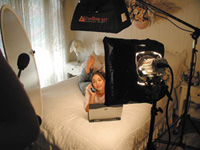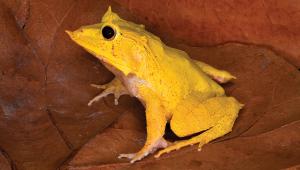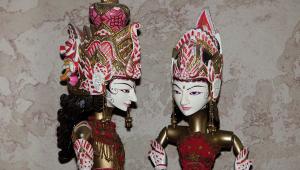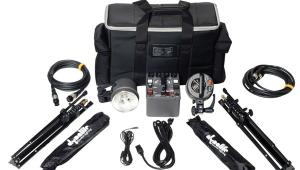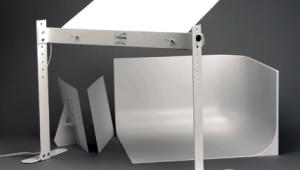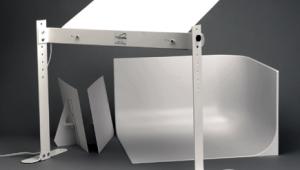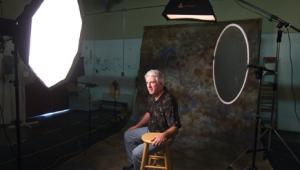Lesson Of The Month
Creating And Modifying Soft Light Indoors
Soft light is created when a light source (sun, light bulb) becomes diffused. Because diffused light renders people and objects in smooth tonal transitions, it works very well when taking portraits. Soft light is often present indoors where the ambient light of the sky comes in through a room window. Window lighting can make for great portraits, particularly when the walls are bright enough to reflect back into the subject for a fill light. |
|||
Window light, however, is photographically limited in a few ways. Oftentimes, there is not enough of this ambient light for a decent camera exposure. And because window light is both unmovable and dependent on the position of the sun, it is difficult to modify or control. This lesson demonstrates how to create and modify portable soft light for custom indoor portraits. In preparation for the shoot, we brought a hair/makeup stylist on location to style our 15-year-old model, Angela. It's important to have someone who functions as a stylist on the set of a portrait shoot. While you are focusing on lighting, camera settings, and getting your subject to interact with the camera, a good stylist focuses on the details of the shot. They will watch for stray hairs, bunched clothing, positioning of props and elements in the background. Our shot concept was to capture Angela as though we had just come upon her working on her laptop in her room. This simple bedroom worked as an ideal portrait spot (#1 and #2). |
|||
As our stylist worked on making Angela's clothing, hair, and makeup, we went about setting up the lighting equipment for the room. To start, we set up a small Photoflex Starlite Kit to be used as our main light. This diffused light source would serve as our "window light." Once Angela was prepped, our stylist brought her into the bedroom. I set up the tripod and mounted an Olympus E-10 digital camera to it in the vertical position. For comparative purposes, I took a shot with the built-in flash of the camera activated. Notice that while the flash helps to fill in the shadows cast from the window light of the room, it also flattens out our model's features and casts sharp shadows from her arms (#3). |
|||
We attached the front diffusion face to the SilverDome and connected the Starlite body to a Photoflex Litestand with casters attached. (The casters help to make subtle positional adjustments to a Litestand.) I switched on the Starlite and positioned the unit slightly to the right of Angela to render subtle shadows across her face. The stylist added a laptop and cell phone to the set as fitting props for a teen-age girl. Props like these are good to use in portraits so long as they don't draw the viewer's attention away from the subject. |
|||
I set the aperture to f/8, set the shutter speed to 1/60 of a sec, and took a shot. I then set the camera to playback, and reviewed the exposure of the image on the LCD (#4 and #5). (One of the advantages to shooting digitally is that you can always ensure a good exposure on the spot thanks to the LCD.) The resulting shot was greatly improved from the built-in flash shot. The SilverDome had created a sense of dimension, yet still provided a soft, wraparound light. This setup also lightened up Angela's eyes considerably. |
|||
Next, we wanted to add a reflective Litedisc to bounce light into the shadow side of Angela's face and body. We attached a 42" soft gold/white Litedisc to a Litedisc holder, secured it to a Litestand with casters, and positioned it to the left of Angela. Keeping the same camera settings, I took #6 and #7. |
|||
The Litedisc worked well to fill in the shadows, but now the shot seemed to lack contrast. We decided to add another SilverDome overhead to create separation from the background. We set up another small SilverDome, secured it to a Photoflex Boom and Litestand, and positioned it over Angela's head. Without changing the camera settings, I took #8 and #9. |
|||
Though the result shows improved lighting on our model, the light from overhead has now brightened the background, again minimizing contrast. To keep this overhead light more directional, I attached a set of grids to the face of the box. This accessory helped keep the background from being hit, while maintaining a soft light on the subject (#10). |
|||
Reviewing our final result, we see a soft, yet directionally lit subject who is set forward from a slightly darker, patterned background. Notice the dramatic difference between the first shot with the built-in flash and our final shots (#11 and #12). |
|||
This lesson will be posted in the free public section of the Web Photo School at: www.webphotoschool.com. You will be able to enlarge the photos from thumbnails. If you would like to continue your digital step by step education lessons on editing, printing, and e-mailing your photos it will be on the private section of the Web Photo School. |
|||
Technical Equipment |
|||
Lighting Equipment:
2 small Photoflex Starlite Kits; small Photoflex grids; 32" Photoflex
soft gold/white Litedisc; Photoflex Litedisc holder; Photoflex Boom; 2
Photoflex LS-2218 Litestands; Photoflex weight bag |
- Log in or register to post comments







